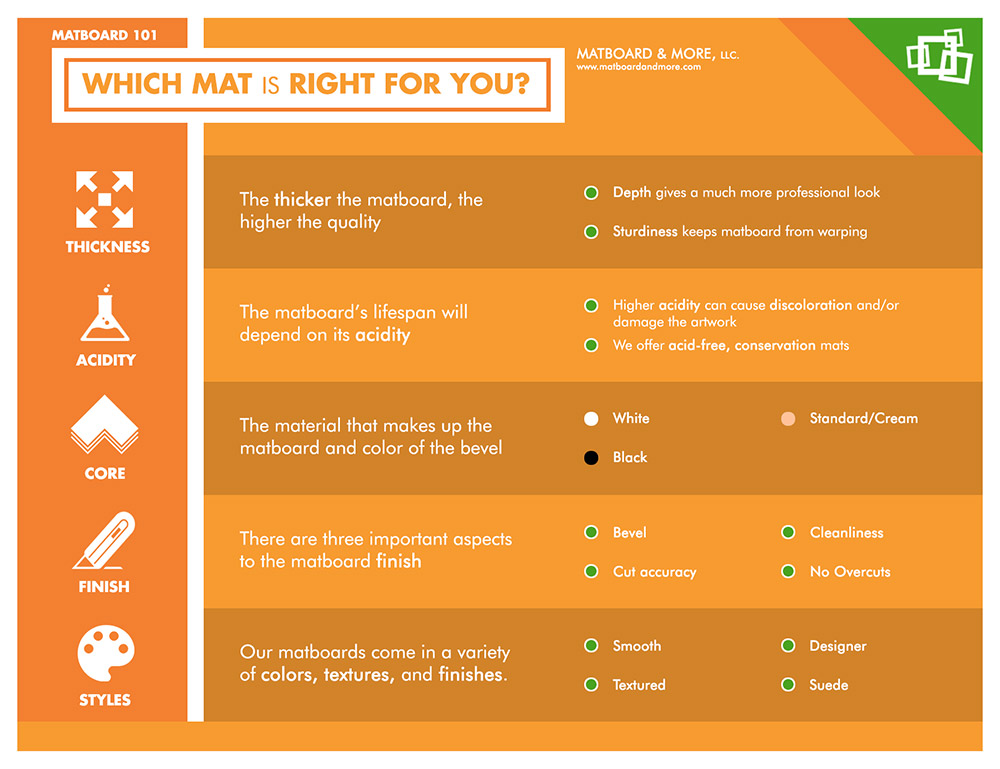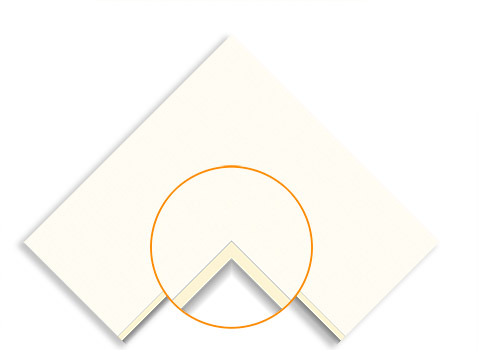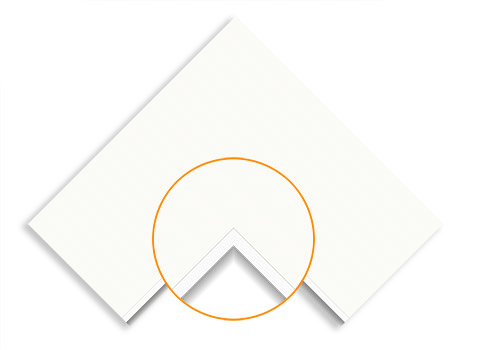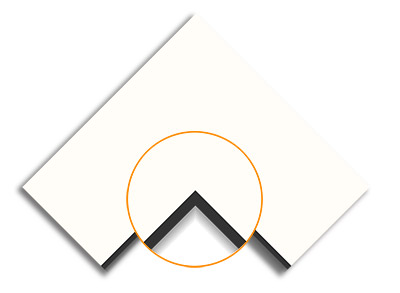Matboard 101
This guide will tell you all you need to know about picture framing and matboards. We start with quality, which is determined primarily by a mats thickness, acidity, core, color (surface/core) and finish. This primer will go into detail about how these different characteristics affect the quality of the matboard.

Finish
The most important aspects of the finish are the bevel, cut accuracy and cleanliness of the mat.
- Bevel: a 45 degree cut is much nicer than a straight cut, and is usually standard. Be sure to clarify that there is a proper bevel cut, as cheap matboards will use a simple press cutter to save money. A dull blade will also result in a rough bevel cut which severely diminishes the photo.
- Cut Accuracy: the cut accuracy is incredibly important as there are many cuts
involved with a finished matboard.
- Opening/Outer Size Accuracy: most mat cutters have 1/16″ tolerance, it’s vital to get the exact size you are looking for so that it fits both the frame and the artwork.
- Over Cut Corners: it’s also important to note the cuts at the corners because with lower quality mats, cuts extend into the border by going beyond the edges.
- Straight Cut on Outside: ensure the outside edge is a straight cut and not also a bevel cut which is a shortcut used by lower quality framers.
- Border Alignment: inside borders should line up perfectly parallel to the outside edge of the matboard.
- Double Mat Alignment: when using multiple mats, if they aren’t perfectly cut and taped together properly the misalignment is very obvious. Most framers won’t tape the two layers for you without an additional charge, Matboard and More® does it for free!
- Cleanliness: it's very easy for the matboard to becomes damaged, scratched or
dirtied when handling,
- Finger Prints/Smudges: it is recommended to handle matboards with gloves to avoid all fingers prints and smudges.
- Bends/Creases: in extreme cases the matboard may have even been bent in handling. It’s quite easy to put a crease in mats, especially larger ones.
Matboard Thickness
Matboard is typically measured in PLY, which is not standardized like inches, making it misleading. Mats come in either 4 PLY (0.040-0.052″) or 8 PLY (0.125″) but that doesn’t mean all PLY are the same. For example, there are 0.040″ 4 PLY and 0.052″ 4 PLY. Double or triple 4 PLY mats can also be used in place of 8 PLY mats to get a similar effect. The thicker the photo mat is, typically the higher the quality and price are. The advantages of a thicker matboard are:
- Depth: greater depth in the art work gives a much more professional look.
- Sturdiness: a very thin matboard will bend or warp, especially when very large.
Our Economy (Berkshire) mats are 0.040″ thick as compared to 0.052″ for the Decorative and Conservation mats, which is part of why Berkshire is the cheapest mat. Conservation matting also comes in 8 PLY and they are our highest quality matboard.
Matboard Acidity
The acidity of a matboard determines how long it will last and be impacted by sunglight and other atmospheric conditions. We split up acidity into two categories, acid free and not acid free. True, 100% acid free is only available in cotton-fibre based matboards, these are used for museum art that needs to preserved for hundreds of years. Paper mat that is made of wood-pulp is often called acid free as the acid is buffered out through a chemical process. These are the Conservation brand of matboards that are sold by most high-end frame shops. The more common paper mat, often called Decorative is not acid free but wll still last many years depending on exposure to sunlight and the quality of the glazing. You’ll find these in retail locations. It’s also important to note that acidity is a factor in both the core of the matboard and the surface. The core is what the matboard is composed of (paper is then adhered to the core to give the matboard color and texture), White and black cores have acid free cores, but not necessarily acid free surfaces which means that the core will retain its color, but the acidic surface will still fade and potentially damage the art work over time. Cream/standard cores are not acid free in either the surface or the core.
Acidity has two main problems:
- Discoloration: the mat will fade or discolor over the years, especially when exposed to lots of light.
- Damages Art: the art work that is exposed to the acidic paper will brown and discolor over the years.
Conservation Select mats are what is commonly called acid free, Berkshire and Decorative mats do not have acid free surfaces.
Cores
The core is the material that the matboard is made of. It is revealed with the bevel cut, the inside edge of the mat after a 45 degree cut is made. It functions as a secondary border and is typically 1/8″ of an inch. Retailers mostly use cream/standard core as it is the cheapest, but white and black core provide a much more professional finish. Core comes in three colors:
- Standard/Cream Core: cheap and used in most retail shops for its low cost, but it will fade and yellow over many years of exposure to light. It will also become brittle.
- White Core: true bright white and will retain its color over many years since it is acid free. Brings out the beauty of your art work much more than the cream core.
- Black Core: true black and will retain its color over many years since it is acid free. Brings out the beauty of your art work much more than the cream core, particularly useful in black and white photos.
Conservation Select mats are what is commonly called acid free, Berkshire and Decorative mats do not have acid free surfaces.

Standard Core Matboard

White Core Matboard

Black Core Matboard
Matboad Color
Matboard color is very difficult to judge, but the higher the quality the sharper and more intense the color is. Matboard can come in many forms:
- Smooth: no texture, smooth surface, the majority of our mats are smooth.
- Textured: a slight pattern or texture which gives the matboard character.
- Suede: suede is much more expensive, is very soft and it looks luxurious.
- Designer: usually higher end matboards, but they can come in colorful patterns or special designs such as basektball, football etc.
